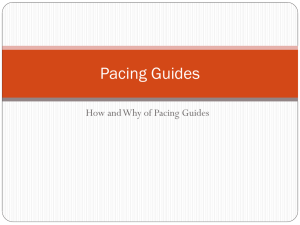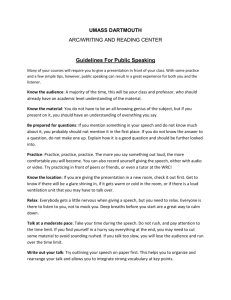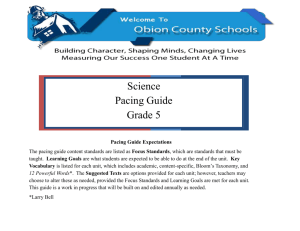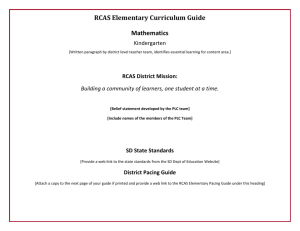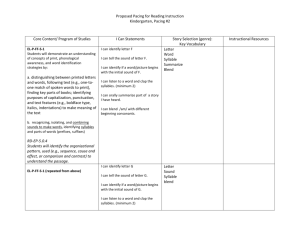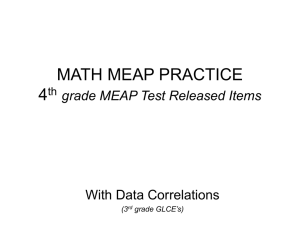Grade 1 Social Studies Pacing Guide
advertisement
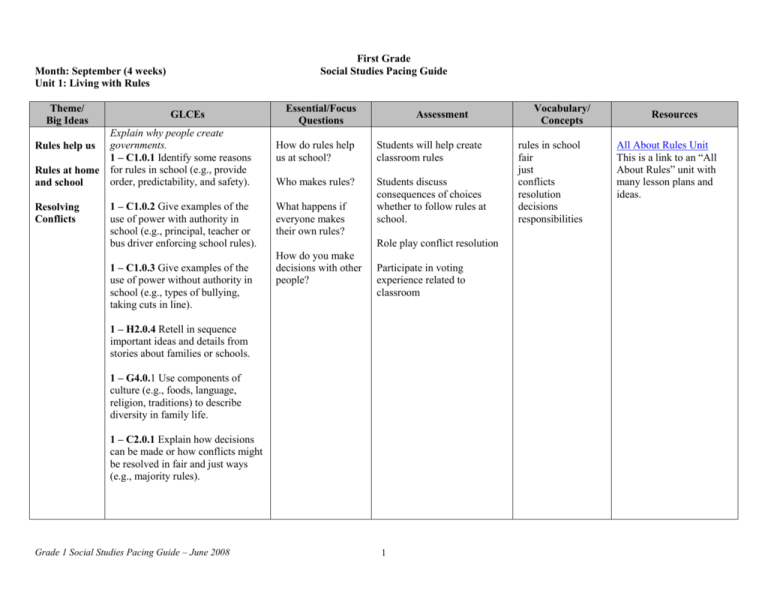
First Grade Social Studies Pacing Guide Month: September (4 weeks) Unit 1: Living with Rules Theme/ Big Ideas GLCEs Explain why people create governments. 1 – C1.0.1 Identify some reasons Rules at home for rules in school (e.g., provide order, predictability, and safety). and school Rules help us Resolving Conflicts 1 – C1.0.2 Give examples of the use of power with authority in school (e.g., principal, teacher or bus driver enforcing school rules). 1 – C1.0.3 Give examples of the use of power without authority in school (e.g., types of bullying, taking cuts in line). Essential/Focus Questions Assessment How do rules help us at school? Students will help create classroom rules Who makes rules? Students discuss consequences of choices whether to follow rules at school. What happens if everyone makes their own rules? Role play conflict resolution How do you make decisions with other people? Participate in voting experience related to classroom 1 – H2.0.4 Retell in sequence important ideas and details from stories about families or schools. 1 – G4.0.1 Use components of culture (e.g., foods, language, religion, traditions) to describe diversity in family life. 1 – C2.0.1 Explain how decisions can be made or how conflicts might be resolved in fair and just ways (e.g., majority rules). Grade 1 Social Studies Pacing Guide – June 2008 1 Vocabulary/ Concepts rules in school fair just conflicts resolution decisions responsibilities Resources All About Rules Unit This is a link to an “All About Rules” unit with many lesson plans and ideas. First Grade Social Studies Pacing Guide Month: October (4 weeks) Unit 2: My Family Theme/ Big Ideas My Family My Address CDV: Fairness and Justice GLCE Use historical thinking to understand the past. 1 – H2.0.1 Demonstrate chronological thinking by distinguishing among past, present, and future using family or school events. 1 – H2.0.2 Use a calendar to distinguish among days, weeks, and months. 1 – H2.0.4 Retell in sequence important ideas and details from stories about families or schools. 1 – G1.0.2 Give examples of places that have absolute locations (e.g., home address, school address). Essential/Focus Questions Where is my family from? Assessment Project: Family Tree Family Tree Template What did my family do? Where do I live? Family Tree Sharing Rubric Use a Venn Diagram to compare and contrast how families are different How is my family special? How does my family make decisions? Understand how human activities help shape the Earth’s surface. 1 – G4.0.1 Use components of culture (e.g., foods, language, religion, traditions) to describe diversity in family life. 1 – C1.0.2 Give examples of the use of power with authority in school (e.g., principal, teacher or bus driver enforcing school rules). Grade 1 Social Studies Pacing Guide – June 2008 2 Vocabulary/ Concepts chronological order past present future calendar days weeks months family history generations address Resources Family Tree Parent Letter Family Printables Click on this site and scroll down to the bottom of the page. Print each family member listed and reduce the size on a photocopier. Then, make enough copies of each family member according to the students' families. Theme/ Big Ideas GLCE Essential/Focus Questions Assessment 1 – C2.0.1 Explain how decisions can be made or how conflicts might be resolved in fair and just ways (e.g., majority rules). Grade 1 Social Studies Pacing Guide – June 2008 3 Vocabulary/ Concepts Resources Month: November/December (4-5 weeks) Unit 3: Families in the Past Theme/ Big Ideas My Family Other Families GLCE Use historical thinking to understand the past. 1 – H2.0.1 Demonstrate chronological thinking by distinguishing among past, present, and future using family or school events. 1 – H2.0.3 Investigate a family history for at least two generations, identifying various members and their connections in order to tell a narrative about family life. 1 – H2.0.4 Retell in sequence important ideas and details from stories about families or schools. 1 – H2.0.5 Use historical records and artifacts (e.g., photos, diaries, oral histories, and videos) to draw possible conclusions about family or school life in the past. First Grade Social Studies Pacing Guide Essential/Focus Questions What happened yesterday, today, and tomorrow? Assessment Collect pictures and other family artifacts to use in creating an “All About My Family” document. Where does my family come from? How can I learn about the past? What was school like for my mom and dad? How do other people live at home? How do people change the environment? 1 – H2.0.6 Compare life today with life in the past using the criteria of family, school, jobs, or communication. Understand how human activities help shape the Earth’s surface. 1 – G4.0.1 Use components of culture (e.g., foods, language, religion, traditions) to describe diversity in family life. Grade 1 Social Studies Pacing Guide – June 2008 4 Vocabulary/ Concepts life today life in the past historical records artifacts Resources Letter to Parents: Introduce Unit and request family information Theme/ Big Ideas GLCE Essential/Focus Questions Assessment Understand the effects of humanenvironment interactions. 1 – G5.0.1 Describe ways in which people modify (e.g., cutting down trees, building roads) and adapt to the environment (e.g., clothing, housing, transportation). Grade 1 Social Studies Pacing Guide – June 2008 5 Vocabulary/ Concepts Resources Month: January/February (6 weeks) Unit 4: Families and the Economy Theme/Big Ideas Money and Trade My Responsibilities GLCE Use fundamental principles and concepts of economics to understand economic activity in a market economy. 1 – E1.0.1 Distinguish between producers and consumers of goods and services. 1 – E1.0.2 Describe ways in which families consume goods and services. 1 – E1.0.3 Using examples, explain why people cannot have everything they want (scarcity) and describe how people respond (choice). First Grade Social Studies Pacing Guide Essential/Focus Questions What are producers and consumers? Assessment Participate in a classroom mini economy What are goods and services? Why do I have to choose? producer consumer good service scarcity choice trade responsibility Resources http://hill.troy.k12.mi.us/st aff/bnewingham/myweb3/ mini-ecomony.htm This is a link to a classroom mini economy idea with lots of templates to download Free Printable Classroom Posters How do I earn money? How do I use money? What are my responsibilities at 1 – E1.0.4 Describe reasons why home and at school? people voluntarily trade. 1 – E1.0.5 Describe ways in which people earn money (e.g., providing goods and services to others, jobs). 1 – E1.0.6 Describe how money simplifies trade. 1 – H2.0.6 Compare life today with life in the past using the criteria of family, school, jobs, or communication. Grade 1 Social Studies Pacing Guide – June 2008 Vocabulary/ Concepts 6 Theme/Big Ideas GLCE Essential/Focus Questions Assessment 1 – C5.0.1 Describe some responsibilities people have at home and at school (e.g., taking care of oneself, respect for the rights of others, following rules, getting along with others). Grade 1 Social Studies Pacing Guide – June 2008 7 Vocabulary/ Concepts Resources Month: February/March (4 weeks) Unit 5: Using Time and Calendars Theme/ Big Ideas Holidays American Symbols GLCE Use historical thinking to understand the past. 1 – H2.0.1 Demonstrate chronological thinking by distinguishing among past, present, and future using family or school events. First Grade Social Studies Pacing Guide Essential/Focus Questions How do I use a calendar? How is my life different than my parents? 1 – H2.0.2 Use a calendar to distinguish among days, weeks, and months. What do we celebrate on President’s Day? 1 – H2.0.6 Compare life today with life in the past using the criteria of family, school, jobs, or communication. What are symbols of America? Assessment Daily Calendar Activities Create craft projects of the Statue of Liberty, Uncle Sam, the White House, or a Bald Eagle 1 – H2.0.7 Identify the events or people celebrated during United States national holidays and why we celebrate them (e.g., Independence Day, Constitution Day, Martin Luther King, Jr. Day; Presidents’ Day). 1 – C2.0.2 Identify important symbols of the United States of America (e.g., Statue of Liberty, Uncle Sam, White House, Bald Eagle). Grade 1 Social Studies Pacing Guide – June 2008 8 Vocabulary/ Concepts national holidays Independence day Martin Luther King Jr. Day Presidents’ Day symbols of USA Statue of Liberty Uncle Sam White House bald eagle diversity Resources Symbols of the United States free Printable Resources President’s Day Resources Month: March (2-3 weeks) Unit 6: Making and Using Maps to Study My Family and Families Around the World Theme/ Big Ideas Maps Boundaries GLCE Use geographic representations to acquire, process, and report information from a spatial perspective. 1 – G1.0.1 Construct simple maps of the classroom to demonstrate aerial perspective. First Grade Social Studies Pacing Guide Essential/Focus Questions Assessment How do you make a map? As a class project, construct a map of your school What are boundaries? Identify the boundaries in your school: Classroom boundaries, playground boundaries, etc. How do people 1 – G2.0.2 Describe the unifying change the characteristics and/or boundaries of environment? different school regions (e.g., playground, reading corner, library, restroom). Understand the effects of humanenvironment interactions. 1 – G5.0.1 Describe ways in which people modify (e.g., cutting down trees, building roads) and adapt to the environment (e.g., clothing, housing, transportation). Grade 1 Social Studies Pacing Guide – June 2008 9 Vocabulary/ Concepts absolute location relative location directions environment school environment boundaries maps globes school regions landmass bodies of water physical characteristics human characteristics unifying characteristics Resources Map Skills Mini-Office This document is from Virginia and would need to be adjusted for Michigan, but has many useful resources. Map Bingo Board 1 Map Bingo Board 2 Map Bingo Board 3 Map Bingo Board 4 Map Bingo Board 5 Map Bingo Board 6 Map Bingo Caller’s Cards Month: April (6 weeks) Unit 7: Working Together for the Common Good Theme/ Big Ideas CDV: Common Good Public Issues GLCE Explain important rights and how, when, and where American citizens demonstrate their responsibilities by participating in government. 1 – C5.0.1 Describe some responsibilities people have at home and at school (e.g., taking care of oneself, respect for the rights of others, following rules, getting along with others). 1 – C5.0.2 Identify situations in which people act as good citizens in the school community (e.g., thoughtful and effective participation in the school decisions, respect for the rights of others, respect for rule of law, voting, volunteering, compassion, courage, honesty). First Grade Social Studies Pacing Guide Essential/Focus Questions What are my responsibilities? Assessment Write about a classroom issue; include an opinion and one supporting statement. How can I be a good citizen? What are issues in our school? How can I learn about issues? How can we resolve issues in our school? How can I share what I learned? Clearly state a problem as a public policy issue, analyze various perspectives, and generate and evaluate possible alternative resolutions. 1 – P3.1.1 Identify public issues in the school community. 1 – P3.1.2 Use graphic data to analyze information about a public issue in the school community. Grade 1 Social Studies Pacing Guide – June 2008 10 Vocabulary/ Concepts environment issues graph resolution responsibilities Resources Theme/ Big Ideas GLCE Essential/Focus Questions Assessment 1 – P3.1.3 Identify alternative resolutions to a public issue in the school community. Communicate a reasoned position on a public issue. 1 – P3.3.1 Express a position on a public policy issue in the school community and justify the position with a reasoned argument. Act constructively to further the public good. 1 – P4.2.1 Develop and implement an action plan to address or inform others about a public issue. 1 – P4.2.2 Participate in projects to help or inform others. Grade 1 Social Studies Pacing Guide – June 2008 11 Vocabulary/ Concepts Resources
